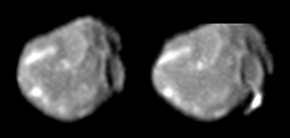Our website is made possible by displaying online advertisements to our visitors.
Please consider supporting us by disabling your ad blocker.
Amalthea (moon)
 Grayscale image of Amalthea from Galileo, 1999 | |||||||||
| Discovery | |||||||||
|---|---|---|---|---|---|---|---|---|---|
| Discovered by | E. E. Barnard | ||||||||
| Discovery date | 9 September 1892 | ||||||||
| Designations | |||||||||
| Pronunciation | /æməlˈθiːə/[1] | ||||||||
Named after | Ἀμάλθεια Amaltheia | ||||||||
| Adjectives | Amalthean /æməlˈθiːən/[2][3] | ||||||||
| Orbital characteristics | |||||||||
| Periapsis | 181150 km[a] | ||||||||
| Apoapsis | 182840 km[a] | ||||||||
Mean orbit radius | 181365.84±0.02 km (2.54 RJ)[4] | ||||||||
| Eccentricity | 0.00319±0.00004[4] | ||||||||
| 0.49817943±0.00000007 d (11 h, 57 min, 23 s)[4] | |||||||||
Average orbital speed | 26.57 km/s[a] | ||||||||
| Inclination | 0.374°±0.002° (to Jupiter's equator)[4] | ||||||||
| Satellite of | Jupiter | ||||||||
| Physical characteristics | |||||||||
| Dimensions | 250 × 146 × 128 km[5] | ||||||||
| 83.5±2.0 km[5] | |||||||||
| Volume | (2.43±0.22)×106 km3[6] | ||||||||
| Mass | (2.08±0.15)×1018 kg[6] | ||||||||
Mean density | 0.857±0.099 g/cm3[6] | ||||||||
| ≈ 0.020 m/s2 (≈ 0.002 g)[a] | |||||||||
| ≈ 0.058 km/s[a] | |||||||||
| synchronous[5] | |||||||||
| zero[5] | |||||||||
| Albedo | 0.090±0.005[7] | ||||||||
| |||||||||
| 14.1[9] | |||||||||
Amalthea /æməlˈθiːə/ is a moon of Jupiter. It has the third-closest orbit around Jupiter among known moons and was the fifth moon of Jupiter to be discovered, so it is also known as Jupiter V. It is also the fifth-largest moon of Jupiter, after the four Galilean moons. Edward Emerson Barnard discovered the moon on 9 September 1892 and named it after Amalthea of Greek mythology.[10] It was the last natural satellite to be discovered by direct visual observation; all later moons were discovered by photographic or digital imaging.
Amalthea is in a close orbit around Jupiter and is within the outer edge of the Amalthea Gossamer Ring, which is formed from dust ejected from its surface.[11] Jupiter would appear 46.5 degrees in diameter from its surface.[b] Amalthea is the largest of the inner satellites of Jupiter and is irregularly shaped and reddish in color. It is thought to consist of porous water ice with unknown amounts of other materials. Its surface features include large craters and ridges.[5]
Close-range images of Amalthea were taken in 1979 by the Voyager 1 and 2 spacecraft, and in more detail by the Galileo orbiter in the 1990s.[5]
- ^ "Amalthea". Merriam-Webster.com Dictionary. Merriam-Webster.
- ^ Basil Montagu (1848) The works of Francis Bacon, vol. 1, p. 303
- ^ Isaac Asimov (1969) "Dance of the Satellites", The Magazine of Fantasy and Science Fiction, vol. 36, p. 105–115
- ^ a b c d Cooper Murray et al. 2006.
- ^ a b c d e f Thomas Burns et al. 1998.
- ^ a b c Anderson Johnson et al. 2005.
- ^ Simonelli Rossier et al. 2000.
- ^ Simonelli 1983.
- ^ Observatorio ARVAL.
- ^ Barnard 1892.
- ^ Burns Simonelli et al. 2004.
Cite error: There are <ref group=lower-alpha> tags or {{efn}} templates on this page, but the references will not show without a {{reflist|group=lower-alpha}} template or {{notelist}} template (see the help page).
Previous Page Next Page


